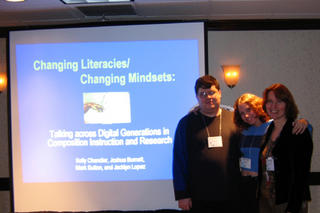On Tuesday, I will present some materials available for teaching multimedia and/or visual rhetoric and design.
 To give you an idea of what web essays look like, you might want to check out Kairos a web journal on writing. These essays are about teaching digital writing, and they are presented in web format.
To give you an idea of what web essays look like, you might want to check out Kairos a web journal on writing. These essays are about teaching digital writing, and they are presented in web format.If you want to see *advanced* design in action, check out entroyp8zuper, a web design studio. Their work is interactive, beautiful, and provides excellent examples of visual communication (for a range of purposes). I do not expect anything so elaborate -- but I thought you might enjoy looking at their work.
You might also want to look at TECFA's links for design. TECFA is an academic unit in the field of educational
technology. It was created by the School of Psychology and Education at the University of Geneva. Scroll down to 2.1
 If you scroll down further, you will discover the web style guide,the web design group's elements of design. These sites contain different presentations of the material which we will go over in class -- or to put it more accurately -- which you will present to your classmates.
If you scroll down further, you will discover the web style guide,the web design group's elements of design. These sites contain different presentations of the material which we will go over in class -- or to put it more accurately -- which you will present to your classmates.After you review/rate one another's wiki sites, you and your group will read through materials for teaching visual/multimedia composing (web design). Then, next week (as scheduled on the new calendar) each group will give a presentation on one set of materials. In the presentation, you will:
1. Give an overview of information in your material which is relevant to web writing; your discussion should cover elements of design, visual rhetorics, relationships between print & text, role of the reader, and so on.
2. Discuss how you could apply this information as you construct your web essay.
3. Evaluate the effectiveness of the teaching material you have reviewed.
The format for the presentation can be interactive, collaborative -- how ever you think will be most engaging for your classmates.

